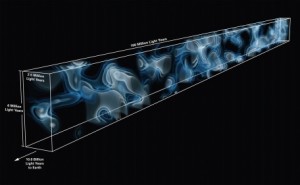 Scientists from the NERSC and Berkeley National Laboratory are using a supercomputer to create one of the most complete, three-dimensional maps of the adolescent universe — using extremely faint light from galaxies 10.8 billion light years away.
Scientists from the NERSC and Berkeley National Laboratory are using a supercomputer to create one of the most complete, three-dimensional maps of the adolescent universe — using extremely faint light from galaxies 10.8 billion light years away.
The map shows a web of hydrogen gas that varies from low to high density at a time when the universe was made of a fraction of the dark matter we see today – just 3 billion years after the Big Bang.
The researchers ran huge cosmological simulations at NERSC, on the Cray XC series supercomputer, to construct mock data and test the mapping models, validating the method and codes they developed for the project. NERSC is experienced with many generations of scalable Cray supercomputers, as it has been using Cray systems dating back to a Cray-1 in the 1970s.
The map was created in part using the Cray XC30 supercomputer “Edison” at the National Energy Research Scientific Computing Center (NERSC) by a team that included researchers from Berkeley Lab’s Computational Cosmology Center (C3).
Edison is NERSC’s newest petaflop system with a peak performance of more than 2 petaflops. It is based on Cray’s XC30 platform and features Intel Ivy Bridge 12-core, 2.4GHz processors, Cray’s Aries interconnect with Dragonfly topology and 3 Lustre scratch file systems configured as 1:1:2 for capacity and performance.
A new study, led by Khee-Gan Lee, a postdoctoral researcher in the Galaxies and Cosmology department at the Max Planck Institute for Astronomy in Heidelberg, Germany and his team at the Max Planck Institute, in conjunction with researchers at Lawrence Berkeley National Laboratory (Berkeley Lab) and UC Berkeley, was published October 16, 2014 in Astrophysical Journal Letters.
A recent white paper produced by Cray details this project and the impact it will have on further cosmology mapping projects in the future. In the white paper David Schlegel, an astrophysicist at Berkeley Lab and co-author of the study, states that in addition to the data provided to researchers from the map itself, this work demonstrates a novel technique for the development of high-resolution universe maps in the future.
The map is created in a similar fashion to a computed tomography (CT) scan, which constructs a three-dimensional image of the human body using combinations of many X-ray images taken from different angles to produce cross-sectional (tomographic) images of a scanned object.
Astronomers traditionally determine the density of hydrogen, using a technique that relies on a phenomenon called Lyman-alpha forest absorption, which is based on the absorption of quasar light. However these quasars are few and far between. In contrast Lee and his colleagues constructed their map from the light of distant background galaxies passing through the cosmic web’s hydrogen gas.
However, the light from these distant galaxies is quite dim compared to that of a quasar so there are significant signal processing challenges to reduce the interference of background light which may interfere with the results. To overcome this researchers had to develop algorithms to subtract light from the sky that would otherwise drown out the light needed to construct the map.
This work has the potential to impact future mapping projects such as the proposed Dark Energy Spectroscopic Instrument (DESI), which is managed by Berkeley lab. The goal of the DESI project is to measure the effect of dark energy on the expansion of the universe. It will obtain optical spectra for tens of millions of galaxies and quasars, constructing the most complete three-dimensional map of the universe to date – spanning the nearby universe to 10 billion light years.
DESI was designed without the possibility of extracting such information from the most distant, faint galaxies,” said Schlegel. “Now that we know this is possible, DESI promises to be even more powerful.”
This story appears here as part of a cross-publishing agreement with Scientific Computing World.




